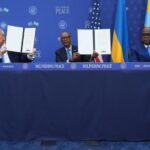
–>
May 23, 2023
The Soviet Union’s 1989 fall marked the end of a half-century-long Cold War, prompting hopes that such globe-spanning conflicts were finally relegated to the past. But in the two decades since 9/11, the resurgence of great-power conflict has effectively extinguished those hopes.
‘); googletag.cmd.push(function () { googletag.display(‘div-gpt-ad-1609268089992-0’); }); document.write(”); googletag.cmd.push(function() { googletag.pubads().addEventListener(‘slotRenderEnded’, function(event) { if (event.slot.getSlotElementId() == “div-hre-Americanthinker—New-3028”) { googletag.display(“div-hre-Americanthinker—New-3028”); } }); }); }
With good reason, many have come to believe, per Michael Lind, that “we are in Cold War II now.”
Meeting such a geopolitical challenge requires that it first be accurately described. On one side stand the world’s liberal democracies, along with several incipient or partial democracies. At the core of this group are the Anglosphere, Western and Central Europe, the democratic “Asian Tigers,” and Israel.
Leading the other side are China, Russia, and Iran — all three being descendants of historically imperial autocracies. Two features of this new Axis of repression make Cold War II especially dangerous: the Axis members’ ruthless genocidal conduct and their exportable model of high-tech totalitarian tyranny. These realities present existential challenges, which demand both the attention and the firm resolve of the democracies.
‘); googletag.cmd.push(function () { googletag.display(‘div-gpt-ad-1609270365559-0’); }); document.write(”); googletag.cmd.push(function() { googletag.pubads().addEventListener(‘slotRenderEnded’, function(event) { if (event.slot.getSlotElementId() == “div-hre-Americanthinker—New-3035”) { googletag.display(“div-hre-Americanthinker—New-3035”); } }); }); }
With respect to genocide, Russia and China are all too experienced in this most malevolent of practices. The 1930s terror-famine in Ukraine, Stalin’s subsequent Great Terror, and China’s absurdly misnamed Great Leap Forward — through these and similar horrors across dozens of gulags and laogai, Russia and China perpetrated tens of millions of mass murders before and during Cold War I.
Russia’s targeting of Ukrainian civilians and China’s genocidal imprisonment and brutalization of a million Uyghurs shows that nothing has changed here in Cold War II. For those on the front lines, this so-called “Cold” War is hot, horrific, and massively murderous.
As for Iran, while its genocidal ambitions remain presently unrealized, its state media make relentlessly clear Iran’s intent to annihilate every last one of Israel’s seven million Jews. Iran’s having surrounded Israel with heavily armed terror syndicates, along with its unceasing rush to build deployable nuclear weapons, makes clear the extreme gravity of this threat.
The readiness of all three countries to unleash and carry out genocides is not just a moral issue of massive proportions. It is also a geopolitical signal of great significance — namely, that these countries will stop at virtually nothing in their pursuit of global dominion.
Moreover, unlike our adversaries in Cold War I, this new alliance presents a second existential threat, the likes of which the democracies have never encountered before: a sophisticated, high technology model of totalitarian governance. Imagine Orwell’s 1984, now powered by semiconductors and supercomputers.
On this front, China is the undisputed leader. As national security expert Daniel Benjamin explains, China has developed, installed, and “is now exporting internationally a suite of surveillance, facial recognition, and data tools that together equip governments to repress citizens on a scale and with a ruthless algorithmic effectiveness that previous generations of strongmen could only dream of.”
‘); googletag.cmd.push(function () { googletag.display(‘div-gpt-ad-1609268078422-0’); }); document.write(”); googletag.cmd.push(function() { googletag.pubads().addEventListener(‘slotRenderEnded’, function(event) { if (event.slot.getSlotElementId() == “div-hre-Americanthinker—New-3027”) { googletag.display(“div-hre-Americanthinker—New-3027”); } }); }); } if (publir_show_ads) { document.write(“
Per the New York Times, several countries around the world are installing “Chinese-made intelligent monitoring systems,” used to track political dissidents and to censor opinions disfavored by the ruling regime. The Council on Foreign Relations published in 2019 a report that “[a]t least 50 countries are developing Huawei-supported surveillance systems.”
Among the reported purchasers of China’s hi-tech tools of repression are Venezuela, Bolivia, Angola, Ecuador, Uzbekistan, Pakistan, Kenya, Singapore, Malaysia, Cambodia, the United Arab Emirates, Ethiopia, Sudan, and Zimbabwe. In just the past year, China was also found to be selling this technology to Iran’s Revolutionary Guard Corps. China makes these purchases especially attractive to its overseas customers by pairing them with loans and expertise for infrastructure development.
In sum, the Axis of Repression led by China, Russia, and Iran has some serious cards to play in competition with the democracies, as well as powerful levers of coercion.
At the same time, the democracies also have several advantages in this new Cold War. America, the Anglosphere, East Asia, Western Europe, and Israel bring tremendous technological assets to the table. Demographically, and hence fiscally, America and Israel are especially well placed to weather the next half century, as against China, Russia, and Iran’s looming demographic and fiscal plunge.
But the free world cannot afford to be complacent. Of particular concern is America’s dangerously shrinking navy, as against China’s robustly expanding fleet. Also needing attention is America’s deteriorating fiscal position, which, while less severe than many developed countries’, remains trending toward a point of no return. And our raging domestic polarization makes ever more difficult the hard fiscal compromises and military upgrades without which America cannot provide the leadership necessary to defeat this Axis of Repression.
Perhaps most important, America’s educational institutions must stop inculcating the next generation in a heavily imbalanced view of our country as little more than a benighted, systemically racist enterprise, and hence a nation unworthy of our loyalty and sacrifice. Slavery, Jim Crow, and bigotry are indeed part of the American story — but only a part. As Bret Stephens writes, “what makes America most itself isn’t four centuries of racist subjugation. It’s 244 years of effort by Americans … to live up to our greatest ideal … [through] a struggle … waged by people of every race and creed” — a struggle that “continues to inspire millions of people at home and abroad.”
In fact, if there is any redeeming aspect whatsoever to the emergence of Cold War II, it is this war’s stark reminder of just how rare and noble the American constitutional order remains among the family of nations past and present. Lincoln was right in 1863 when he described America as the “last best hope of earth.” It remains so today, and it is abundantly worthy of the sacrifices needed to preserve it.
Henry Kopel is a former U.S. federal prosecutor and the author of War on Hate: How to Stop Genocide, Fight Terrorism, and Defend Freedom (Lexington Books, 2021).

Image: Marco Verch via Flickr, CC BY 2.0.
<!–
–>
<!– if(page_width_onload <= 479) { document.write("
“); googletag.cmd.push(function() { googletag.display(‘div-gpt-ad-1345489840937-4’); }); } –> If you experience technical problems, please write to [email protected]
FOLLOW US ON
<!–
–>
<!– _qoptions={ qacct:”p-9bKF-NgTuSFM6″ }; ![]() –> <!—-> <!– var addthis_share = { email_template: “new_template” } –>
–> <!—-> <!– var addthis_share = { email_template: “new_template” } –>





